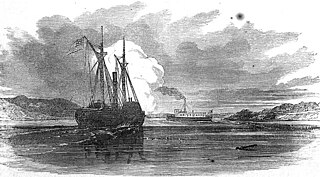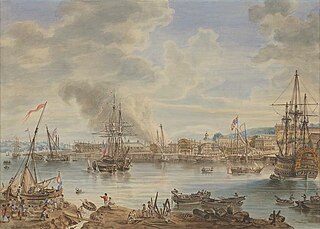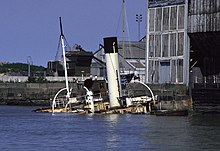
Barge often refers to a flat-bottomed inland waterway vessel which does not have its own means of mechanical propulsion. The first modern barges were pulled by tugs, but on inland waterways, most are pushed by pusher boats, or other vessels. The term barge has a rich history, and therefore there are many other types of barges.

Chatham is a town located within the Medway unitary authority in the ceremonial county of Kent, England. The town forms a conurbation with neighbouring towns Gillingham, Rochester, Strood and Rainham.

A tugboat or tug is a marine vessel that manoeuvres other vessels by pushing or pulling them, with direct contact or a tow line. These boats typically tug ships in circumstances where they cannot or should not move under their own power, such as in crowded harbors or narrow canals, or cannot move at all, such as barges, disabled ships, log rafts, or oil platforms. Some are ocean-going, and some are icebreakers or salvage tugs. Early models were powered by steam engines, which were later superseded by diesel engines. Many have deluge gun water jets, which help in firefighting, especially in harbours.

A paddle steamer is a steamship or steamboat powered by a steam engine that drives paddle wheels to propel the craft through the water. In antiquity, paddle wheelers followed the development of poles, oars and sails, where the first uses were wheelers driven by animals or humans.

Chatham Dockyard was a Royal Navy Dockyard located on the River Medway in Kent. Established in Chatham in the mid-16th century, the dockyard subsequently expanded into neighbouring Gillingham.

PS Kingswear Castle is a steamship. She is a coal-fired river paddle steamer, dating from 1924 with engines from 1904. After running summer excursions on the River Medway and the Thames for many years she returned to the River Dart in Devon in December 2012 to run excursions from 2013 onwards on the river she was built on and for. Kingswear Castle is listed as part of the National Historic Fleet of ships of "Pre-eminent National Significance".

The PS Medway Queen is a paddle driven steamship, the only mobile estuary paddle steamer left in the United Kingdom. She was one of the "little ships of Dunkirk", making a record seven trips and rescuing 7,000 men in the evacuation of Dunkirk.

The San Francisco Maritime National Historical Park is located in San Francisco, California, United States. The park includes a fleet of historic vessels, a visitor center, a maritime museum, and a library/research facility. Formerly referred to as the San Francisco Maritime Museum, the collections were acquired by the National Park Service in 1978. The San Francisco Maritime National Historical Park was authorized in 1988; the maritime museum is among the park's many cultural resources. The park also incorporates the Aquatic Park Historic District, bounded by Van Ness Avenue, Polk Street, and Hyde Street.

Eppleton Hall is a paddlewheel tugboat built in England in 1914. The only remaining intact example of a Tyne-built paddle tug, and one of only two surviving British-built paddle tugs, she is preserved at the San Francisco Maritime National Historical Park in San Francisco, California.

Sydney Heritage Fleet, is the trading name of Sydney Maritime Museum Ltd., a public company in Sydney, New South Wales, Australia.

The Alexander Arbuthnot is the last paddle steamer built as a working boat during the riverboat trade era on the Murray River, Australia.

Sheerness Dockyard was a Royal Navy Dockyard located on the Sheerness peninsula, at the mouth of the River Medway in Kent. It was opened in the 1660s and closed in 1960.

ST Cervia was built in 1946 as a seagoing tug for use as a fleet auxiliary by Alexandra Hall & Company Ltd of Aberdeen, Scotland. Today she is a floating Museum still undergoing restoration in Ramsgate, Kent.
John Payne Ltd was a shipbuilder in Bristol, England, who built coastal colliers and cargo ships, and small craft such as tugs, during the 19th and 20th centuries.

Mayflower is a steam tug built in Bristol in 1861 and now preserved by Bristol Museums Galleries & Archives. She is based in Bristol Harbour at M Shed. She is the oldest Bristol-built ship afloat, and is believed to be the oldest surviving tug in the world.
Bow, McLachlan and Company was a Scottish marine engineering and shipbuilding company that traded between 1872 and 1932.

PS Pevensey is a historic paddle steamer, with its original steam engine, in the fleet of steamers at Echuca Wharf, Victoria, Australia. Built in 1911, it traded on the Murray River until about 1958. In 1973 it was brought by Echuca for restoration and now operates as a tourist boat.

SB Pudge is a wooden Thames sailing barge, built in Rochester, Kent, England in 1922. Her hull was pitch pine on oak frame. She was originally spritsail rigged with bowsprit. An auxiliary oil engine made by The Bergius Co.Ltd of Glasgow was installed in 1932. She was used to carry various cargoes for the London & Rochester Trading Co until 1968, when she was bought out of trade by the Thames Sailing Barge Trust. Her last cargo was pineapple juice.

HMS Hearty was a fishery protection vessel and survey ship of the British Royal Navy. Built by the Scottish shipbuilder W. B. Thompson as the tug Indra, the ship was launched in 1885 and purchased by the Royal Navy. Hearty was sold in 1920 for use as a salvage vessel. She was renamed Dalhousie in 1921, and was sold for scrap in 1930, being scrapped in 1935.



















